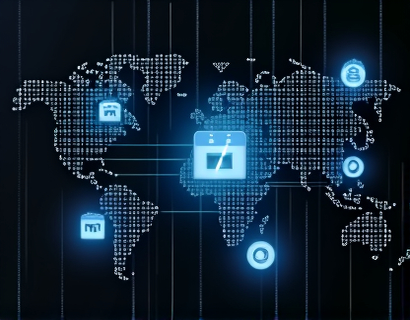Blockchain-Powered Asset Tokenization: Bridging Physical Assets with Digital Liquidity for Enhanced Market Accessibility
Blockchain technology is at the forefront of transforming traditional asset management by introducing a novel method for tokenizing real-world assets. This innovative approach not only enhances liquidity but also broadens market accessibility, creating a more inclusive and efficient financial ecosystem. By integrating physical assets into the digital realm, stakeholders can benefit from secure, transparent, and streamlined transactions, unlocking new opportunities for investment and asset management.
The concept of asset tokenization involves representing physical assets, such as real estate, art, and infrastructure, as digital tokens on a blockchain. These tokens are unique digital representations that mirror the properties and value of the underlying asset. The use of blockchain ensures that these tokens are immutable, tamper-proof, and easily transferable, thus addressing some of the key challenges associated with traditional asset management.
Enhancing Liquidity through Tokenization
One of the primary benefits of asset tokenization is the significant enhancement in liquidity. Traditional assets are often illiquid, meaning they cannot be quickly bought or sold without affecting their price. Tokenization changes this dynamic by allowing asset owners to divide their holdings into smaller, tradable units. This fractional ownership model makes it possible for a broader range of investors to participate in the market, thereby increasing the demand and liquidity of these assets.
For instance, a commercial property worth millions can be tokenized into thousands of smaller units, each representing a fraction of the property's value. These tokens can then be bought and sold on digital platforms, providing investors with the flexibility to enter and exit positions more easily. This increased liquidity not only attracts more investors but also improves market efficiency by reducing the bid-ask spread and transaction costs.
Expanding Market Accessibility
Asset tokenization democratizes access to investment opportunities that were previously reserved for high-net-worth individuals and institutional investors. By lowering the entry barriers, tokenization enables retail investors to participate in the market with smaller capital requirements. This shift has the potential to level the playing field, fostering a more diverse and vibrant financial ecosystem.
Moreover, the global nature of blockchain technology means that tokenized assets can be accessed and traded by anyone with an internet connection, regardless of geographical location. This global reach opens up new markets and investor bases, further enhancing the liquidity and value of tokenized assets.
Security and Transparency
Security and transparency are paramount in asset management, and blockchain technology excels in these areas. The decentralized and distributed ledger system ensures that all transactions are recorded in a transparent and immutable manner. This transparency builds trust among participants, as they can verify the authenticity and history of each token without relying on intermediaries.
Additionally, smart contracts, which are self-executing contracts with the terms directly written into code, automate and enforce the rules of asset transactions. This reduces the risk of fraud and errors, further enhancing the security of the tokenization process. Investors can have confidence that their assets are safely stored and that transactions are executed as intended.
Efficiency and Cost Reduction
The traditional asset management process often involves numerous intermediaries, such as brokers, lawyers, and custodians, which can lead to higher costs and longer transaction times. Tokenization streamlines these processes by eliminating the need for many of these intermediaries. Smart contracts can automate tasks such as payment processing, ownership transfer, and compliance checks, reducing the need for manual intervention.
This automation not only speeds up transactions but also significantly reduces associated costs. Lower transaction fees and faster settlement times make the market more attractive to a wider range of investors, further boosting liquidity and market activity.
Case Studies and Real-World Applications
Several notable projects have already demonstrated the potential of blockchain-powered asset tokenization. One prominent example is the tokenization of real estate. Companies like RealT have successfully tokenized commercial properties, allowing investors to buy, sell, and trade fractions of these properties on digital platforms. This has opened up new investment opportunities and increased the liquidity of real estate assets.
In the art world, platforms like SuperRare use blockchain to tokenize unique digital and physical art pieces. This ensures provenance and authenticity, while also providing artists with new ways to monetize their work. Collectors can purchase fractions of these tokens, making high-value art more accessible to a broader audience.
Another area where tokenization is making waves is in the infrastructure sector. Projects like the tokenization of renewable energy assets allow individuals to invest in and benefit from green energy initiatives. This not only promotes sustainable investment but also democratizes access to renewable energy projects.
Challenges and Considerations
Despite the numerous benefits, asset tokenization is not without its challenges. Regulatory uncertainty remains a significant hurdle, as different jurisdictions have varying approaches to blockchain and tokenized assets. Compliance with securities laws and anti-money laundering regulations is crucial to ensure the legitimacy and sustainability of tokenization projects.
Technical challenges, such as scalability and interoperability, also need to be addressed to support widespread adoption. Blockchain networks must be able to handle a high volume of transactions efficiently, and different blockchain platforms should be able to communicate and transfer assets seamlessly.
Education and awareness are additional factors to consider. Both investors and asset holders need to understand the mechanics of tokenization and the associated risks. Providing comprehensive educational resources and support can help mitigate these challenges and foster a more informed and confident user base.
Future Prospects
The future of asset tokenization looks promising, with ongoing advancements in blockchain technology addressing current limitations. The development of more scalable and efficient blockchain platforms, such as layer 2 solutions and cross-chain interoperability protocols, will enhance the capabilities of tokenized assets.
Furthermore, the integration of other technologies, such as the Internet of Things (IoT) and artificial intelligence (AI), can add new dimensions to asset tokenization. For example, IoT devices can provide real-time data on the condition and performance of physical assets, while AI can optimize investment strategies and risk management.
As the ecosystem matures, we can expect to see more innovative applications of asset tokenization across various industries. From real estate and art to infrastructure and commodities, the potential for enhancing market accessibility and liquidity is vast.
In conclusion, blockchain-powered asset tokenization represents a transformative shift in asset management. By bridging the gap between physical assets and the digital world, this technology offers secure, transparent, and efficient solutions that unlock new opportunities for investors and asset holders. As the market continues to evolve, the benefits of tokenization will become increasingly evident, paving the way for a more inclusive and dynamic financial landscape.










































